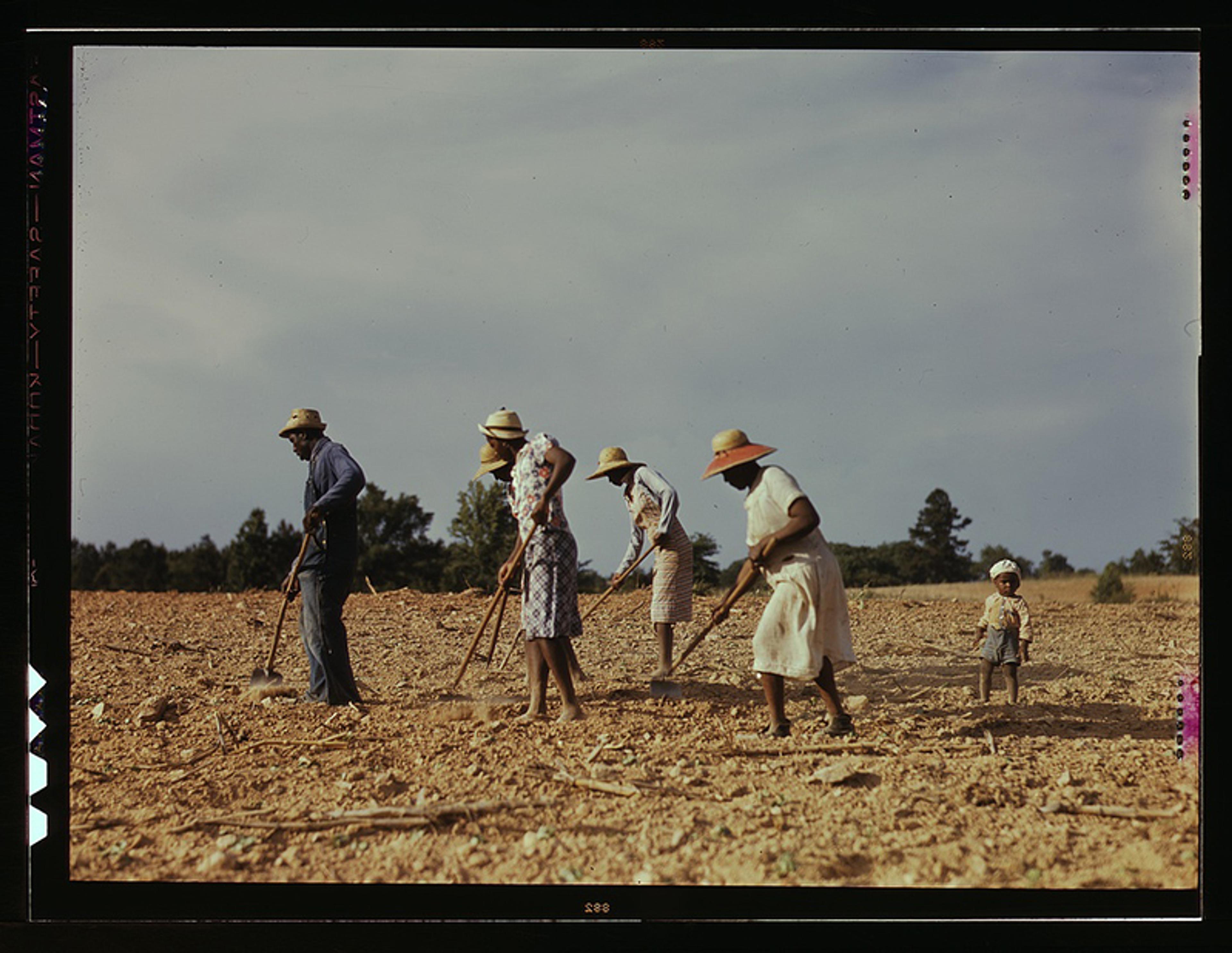
Understand that capitalisim is no good to you if it is reserved to just the KING and his CRONYS. The south has been chronically starved for personal capital which we have steadily been overcoming but it is still applied piecemeal compared to everywhere else.
At least peonage has ended and most have fled north where business loans are possible. It has still been a slow drawn out process and certainly hindered at best by the old guard and even unwitingly at that.
If you expect peonage as part of your culture ,then lending decissions are affected. it is just that simple.
Because of institutional inflation it is always possible to use a government guarantee to invest in yourself in your twenties and then step it up a decade later. this creates individual wealth for most. The south has culturally denied this to folks.
.
The southern gap
Chopping cotton on rented land near White Plains, Greene County, Georgia. June 1941.
is an independent scholar and historian. Her research focuses on race, class, labour, law, poverty and power. She is the author of Masterless Men: Poor Whites and Slavery in the Antebellum South (2017), co-editor of Reconsidering Southern Labor History: Race, Class, and Power (2018), and has a bio of Lillian Smith coming out with St Martin’s Press in 2025. She lives in Atlanta, Georgia, US.
In the American South, an oligarchy of planters enriched itself through slavery. Pervasive underdevelopment is their legacy
In 1938, near the end of the Great Depression, the US president Franklin Delano Roosevelt commissioned a ‘Report on the Economic Conditions of the South’, examining the ‘economic unbalance in the nation’ due to the region’s dire poverty. In a speech following the report, Roosevelt deemed the South ‘the nation’s No 1 economic problem’, declaring that its vast levels of inequality had led to persistent underdevelopment.
Although controversial, Roosevelt’s comments were historically accurate. The president’s well-read and highly educated young southern advisors had convinced him that the South’s political problems were partially a result of ‘economic colonialism’ – namely, that the South was used as an extractive economy for the rest of the nation, leaving the region both impoverished and underdeveloped. Plantation slavery had made the planters rich, but it left the South poor.
Unlike the industrialising North and, eventually, the developing and urbanising West, the high stratification and concentrated wealth of the 19th-century South laid the foundations for its 20th-century problems. The region’s richest white people profited wildly from various forms of unfree labour, from slavery and penal servitude to child indenture and debt peonage; they also invested very little in roads, schools, utilities and other forms of infrastructure and development. The combination of great wealth and extreme maldistribution has left people in the South impoverished, underpaid, underserved and undereducated, with the shortest lifespans in all of the United States. Southerners, both Black and white, are less educated and less healthy than other Americans. They are more violent and more likely to die young.
report, the South has returned to historically high levels of economic inequality, lagging behind the rest of the US by every measurable standard. The plight of the South is a direct result of its long history of brutal labour exploitation and its elites’ refusal to invest in their communities. They have kept the South in dire poverty, stifled creativity and innovation, and have all but prevented workers from attaining any kind of real power.
With the rapid industrialisation spurred by the Second World War, the South made great economic strides, but never quite caught up with the prosperity of the rest of the US. While the South’s gross domestic product has remained around 90 per cent of the US rate for dozens of years, deindustrialisation of the 1990s devastated rural areas. Since then, hospitals and medical clinics have closed in record numbers, and deaths of despair (those from alcohol, drugs or suicide) have skyrocketed, as has substance abuse. Southerners in general are isolated and lonely, and wealth and power are heavily concentrated: there are a few thousand incredibly wealthy families – almost all of them the direct descendants of the Confederacy’s wealthiest slaveholders – a smaller-than-average middle class, and masses of poor people, working class or not. The South, with few worker protections, prevents its working classes from earning a living wage. It’s virtually impossible to exist on the meagre income of a single, low-wage, 40-hour-a-week job, especially since the US has no social healthcare benefits.
The American South is typically defined as the states of the former Confederacy, stretching north to the Mason-Dixon line separating Maryland from Pennsylvania, and west to Texas and Oklahoma. Today, one-fifth of the South’s counties are marred with the ‘persistent poverty’ designation, meaning they have had poverty rates above 20 per cent for more than 30 years. Four-fifths of all persistently poor counties in the nation are in the states of the former Confederacy. The data is clear that most Southern states continue to be impoverished and politically backwards. Whether measured in terms of development, health or happiness, the region is bad at everything good, and good at everything bad.
The South was portrayed as anti-capitalist: enslavers had to be dragged into modernity against their wills
The recent popularity in liberal circles of the New History of Capitalism (NHC) to explain the region’s exceptionalism has slowed in recent years. The NHC emerged in the 2000s and 2010s, as one historian wrote, by claiming ‘slavery as integral, rather than oppositional, to capitalism.’ It seems likely that during the post-Cold War triumph of capitalism, a subset of historians began trying to tie much of the past to the term – with the most extreme instance being the insistence that slavery was the key to American capitalism. While the NHC scholars rarely define terms like ‘capitalism’, the problems with their theories are more than academic. Unfortunately, presenting enslavers as cunning, profit-driven businessmen not only obscures important features about the past, it also downplays immense regional differences in economic development.
Thinking back over the NHC trends, it is important to note how other scholars, both past and present, have presented the problems of the region, and discuss issues that may have been obscured by a heavy emphasis on business and ‘slavery’s capitalism’. As the economic historian Gavin Wright has pointed out, the NHC’s central claim, echoed in The New York Times’ Pulitzer Prize-winning ‘1619 Project’ – that slavery was essential for American economic growth – ignored decades of accepted historiographical work on capitalism and slavery. It also contradicted nearly everything economists have argued regarding slavery’s impact on the South’s (under)development.
Beginning in the 1960s, many historians classified the South, from the days of slavery until the Second World War, as distinctively precapitalist in significant ways. They saw the region as having a type of ‘merchant’ or ‘agrarian’ capitalism, and never considered the states of the Old Confederacy as shrewdly ‘capitalist’ (the term itself without any modifiers). Primarily due to the absence of a free labour society, but also because of the lack of infrastructure and development within the region – a place with few cities, little industrialisation, and few social services – the South was often portrayed as distinctly anti-capitalist: enslavers had to be dragged into modernity against their wills.
After the Second World War industrialisation boom ushered the South into a more fully capitalist society, it essentially became a colonial economy to the North, as it courted investment and corporations from the capital-rich Northeastern US. Existing in a dependency-type of relationship, it was never really the South – or southern labour, no matter how unfree or brutalised – driving the US economy.
Finally, contrary to the position that American slavery represents the key or essence of capitalism, the most recent scholarship regarding economic analysis of slavery argues that the institution was not economically efficient. All these points highlight the need for studies on growth, and more importantly, on underdevelopment. Slavery made the planters very rich, but it made the South very poor. In the 19th century, capitalism, even industrial capitalism, did not bring the South to the developmental standards of the rest of the nation. The question remains: why is that so?
If we turn from looking at planters to studying labour, we see that elite capture of the state is bad for democracy and worse for development. It also helps us distinguish between growth and development, highlighting the unevenness of both in different areas of the US. The US is a large country and awareness of the difference between growth and development can help us see that perhaps it makes more sense to compare the American South with places in the Global South rather than the American North or West.
To begin with, southern militias proved an effective imperial military tool during the brutal process of Indian Removal, which lasted into the 20th century. The white colonialist push westward robbed Native Americans of the greatest wealth the region has: land. That land eventually became the richest white people’s main source of power, owned by the few and guarded like a religion. Elite white southerners were obsessed with intermarriage and have kept their fortunes intact for generations. While they hoarded riches and resources for themselves, they neglected to invest in the communities in which they lived. With few improvements in technology and development, the South’s dependence on slavery enriched enslavers and their descendants, but it left the rest of the region, both people and resources, deeply and cyclically impoverished.
Americans think of the US as having been at a crossroads in 1860, between slavery and freedom, but that impasse was more than just political and ideological: it was also economic. While the North had made fantastic gains over the previous decades by investing in its people, from education to infrastructure, the South lagged far behind. The wealthy enslavers refused to invest in the poor and middling-class whites surrounding them, finding no compelling reason to put money into communities they would move away from as soon as the western spread of slavery beckoned. In terms of development, whether infrastructure, education, healthcare or wealth distribution, the South remained woefully underdeveloped in comparison with the rest of the country.
The Deep South instead functioned more like an oligarchy or aristocracy
With one-third of the nation’s population in 1860, the South was responsible for only 10 per cent of US manufacturing output, and possessed only 10 per cent of the nation’s manufacturing labour force and 11 per cent of its manufacturing capital. Its transportation system, best described as like a ‘conveyor-belt’, transported goods effectively but did little for people. The northern and even western US had been investing in building schools and providing free public education, but the cotton South left its people to fend for themselves: education was reserved for the rich. The North built hospitals, asylums and places for the invalid and indigent; the South built jails and prisons.

Plantation scene 1880 - 1897. Photo by William Hewnry Jackson/LoC
Far from a democratic region, the Deep South instead functioned more like an oligarchy or aristocracy. As W E B Du Bois wrote in 1935: ‘Even among the 2 million slaveholders, an oligarchy of 8,000 really ruled the South.’ The wealthiest slaveholders wielded immense and pervasive power as lawmakers, law-enforcers, judges and even jury members. They dominated the region’s politics and devised multiple ways to disenfranchise their poorer fellow countrymen. The oligarchic structure of the 19th-century South meant that the men who controlled government also controlled everything else in society, from rental properties and bank loans to arrest warrants and vigilante violence.
In fact, the enormous cost of the South’s implementation of its various forms of unfree labour still haven’t been adequately calculated. The ubiquitous, police-state-like criminal justice system, complete with slave patrols and night riders, the overseers and slave-drivers and catchers and other middlemen who had to be hired to keep people working – none of that has truly been accounted for yet. Recently, the economists Richard Hornbeck and Trevon Logan challenged decades of accepted scholarship concerning the cost-effectiveness of slavery, arguing that slavery was inefficient when ‘including costs incurred by enslaved people themselves’. Under this view, emancipation produced major economic gains.
The first years of Reconstruction brought immense changes to the South: a free labour economy threatened to change the entire social order as Black politicians courted poor white voters for a cross-racial, class-based coalition. For the first time, the region experienced democratic elections, open to all men, Black and white. The new state legislators established a system of public education. They began funding public works and infrastructure. They started developing the region.
Despite these transformations, former slaveholding families remained rich – and powerful – because they held a near-monopoly of the only real capital left in the war-torn South: land. The leaders of the Confederate insurrection were never held accountable for treason, and the same few wealthy white families who ruled the slave South remained entrenched in power even after the war. Their enduring place at the top of Southern society helped give rise to the ‘continuity thesis’, in which some scholars argue that, despite the Civil War and Reconstruction, little changed in the US South. In many rural areas, even today, their heirs still lord over their little locales. The South’s ruling elite eventually regained complete control of the region, disenfranchising the masses, terrorising the leaders and the intellectuals and the brave, and undergirding this shadow world of unfreedoms with the ever-present threat of violence.
The Southern elite may have, eventually, emerged from Reconstruction back on top of the South, but the region no longer dominated US politics. The US South remained overwhelmingly agricultural well into the 20th century and long after the rest of the country had become more urban. From the vital perspective of social and labour relations, the South’s transition to capitalism must be considered as late by US standards. In the 1940s and ’50s, historians began arguing that the type of capitalism in the South throughout the early 20th century was merchant capitalism (also known as mercantile, or agrarian capitalism), not industrial capitalism. Merchant capitalism is considered the earliest phase in the transition to capitalism; it is more about moving goods to market, and is characterised by the lack of industrialisation, wage labour and commercial finance. A modified version of the merchant capitalism model would be championed several decades later by Eugene Genovese whose southern ‘in but not of’ capitalism theory, replete with semi-feudalistic social relations, appeared in the 1960s and generated great interest and debate, and eventually, in the early 2000s, came under sustained attack by some US historians who emerged following the end of the Cold War.
These scholars, who eventually came to be grouped under the designation ‘the New History of Capitalism’, never truly engaged with the consequences of the fact that the slave South, in a strict sense, cannot be considered capitalist because the enslaved are unfree, forced labourers who cannot sell their labour power. Even if we sidestep the slavery-as-labour issue, vital to Marxist assessments of capitalist society, we must acknowledge that impoverished southern whites also had little to no control over their respective labour power. The power of enslaved labour consistently reduced the demand for workers, lowered their wages, and rendered their bargaining power weak to worthless. Labourers in the South, regardless of race, worked within a world ruled by degrees of freedom. Never a stark dichotomy, freedom emerged from a give-and-take process of political contestation and negotiation with the planter aristocracy. Slavery was simply one form – albeit the harshest – of a range of unfreedom, lasting well into the 20th century.
But these merchant capitalist labour market features were not simply rooted in the racism of southern white culture. Instead, elite white southerners ensured a calculated and well-codified social order, complete with exploitative labour practices, debt peonage, and continuing forms of unfree labour made possible by the burgeoning criminal justice system. To maintain power and thus control of the region, at times the elite chose to forgo higher profits in the short term so that they could keep their labour force under tighter control in the long term. This was certainly the case with industrialisation during slavery, when enslavers could have turned a much higher profit by industrialising but chose not to; they did not want to disturb the fragile hierarchy.
South Carolina – the birthplace of the Confederacy – has the lowest union membership, at 2 per cent
Compared with the rest of the US, with only a brief interruption during early Reconstruction, the South’s lack of labour power, infrastructure and internal development extended well into the 20th century. Between the violence the Ku Klux Klan and other white supremacists, and the lack of opportunities for poor and working-class southerners, by the mid-1870s former slaveholders and their descendants were back in complete control of the South. Due to the absence of land reform, reparations and the failure to punish Confederate leaders or confiscate Confederate property, the labour lords of the antebellum period merely became the landlords of the postbellum period. Their primary source of wealth changed, but they remained in power, controlling everything in the South and reverting to their old ways of undertaxing, underfunding and underdeveloping.
Given these facts, before the popularity of ‘the New History of Capitalism’ 20 years ago, many historians viewed the transition from slavery to capitalism as a long process because, even after emancipation, unfree labour continued to dominate a significant portion of the labour market. Some argued that forms of unfree labour persisted in the South as late as the 1920s and ’30s, and others claimed they lasted until the Second World War. Even when technically free, African American workers generally lacked the labour power necessary to be deemed a proletariat, able to effectively negotiate on a labour market. Due to predatory sharecropping contracts and debt peonage, an extremely punitive criminal justice system, and the added layer of domestic terrorism from white supremacists, the poorest people in the South, both Black and white, still worked in a society in which labour was not entirely free, that is, able to be brought to a labour market.
The South’s shadowland of unfree labour rested entirely on an undemocratic government, also meant to control labour. In the 1880s and ’90s, when Farmers’ Alliances and Populism began mounting a serious political challenge to planter domination, every southern state passed laws limiting the vote. While primarily aimed at disenfranchising Black people, the laws also disenfranchised poor white people, further concentrating each state’s political power in the hands of white elites in plantation districts. It was an effective strategy: in 1880 there were 160,000 union members in the US, and fewer than 6 per cent of them lived in the South. Today, while a record low of just 10 per cent of Americans are union members, the South’s numbers are roughly half of that, with states like South Carolina – the birthplace of the Confederacy – having the lowest union membership in the nation, just over a measly 2 per cent.
During the last third of the 19th century, the value of output rose and capital investment in the US increased tenfold. Meanwhile, most of the Deep South (outside of a few large cities like Atlanta and New Orleans) remained ‘capital starved’ and ‘technologically laggard’, as the region’s elite continued to baulk at infrastructure or other kinds of developmental investment. To secure funding, the states of the former Confederacy needed to court investment from outside the region – first the North and West, later Europe and Asia. Originally, southern politicians chased northern capital by offering them generous tax breaks and other financial incentives. Without a strong tax base or an effective bureaucracy, the region suffered further because most profits were routed out of the South back to northern owners and investors. Taken together, these things meant that, well into the 20th century, the South remained overwhelmingly rural, without a strong system of infrastructure and no good plan for development. In 1900, the country was 40 per cent urban versus the South’s 18 per cent, and 25 per cent of the US labour force was involved in manufacturing versus the South’s 10 per cent. Something had to drastically change.
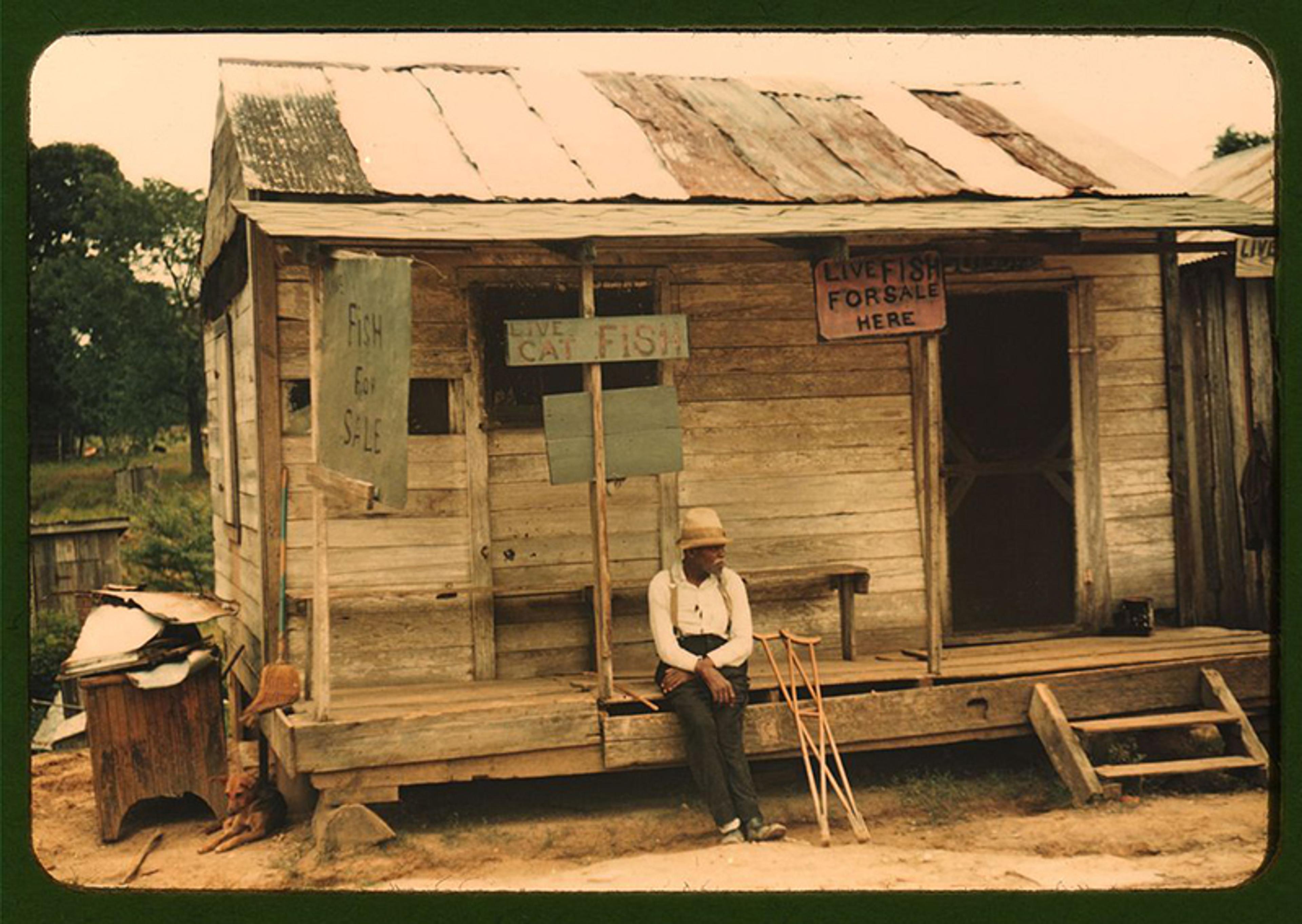
Natchitoches, Louisiana. July 1940. All photos Marion Post Wolcott/LoC
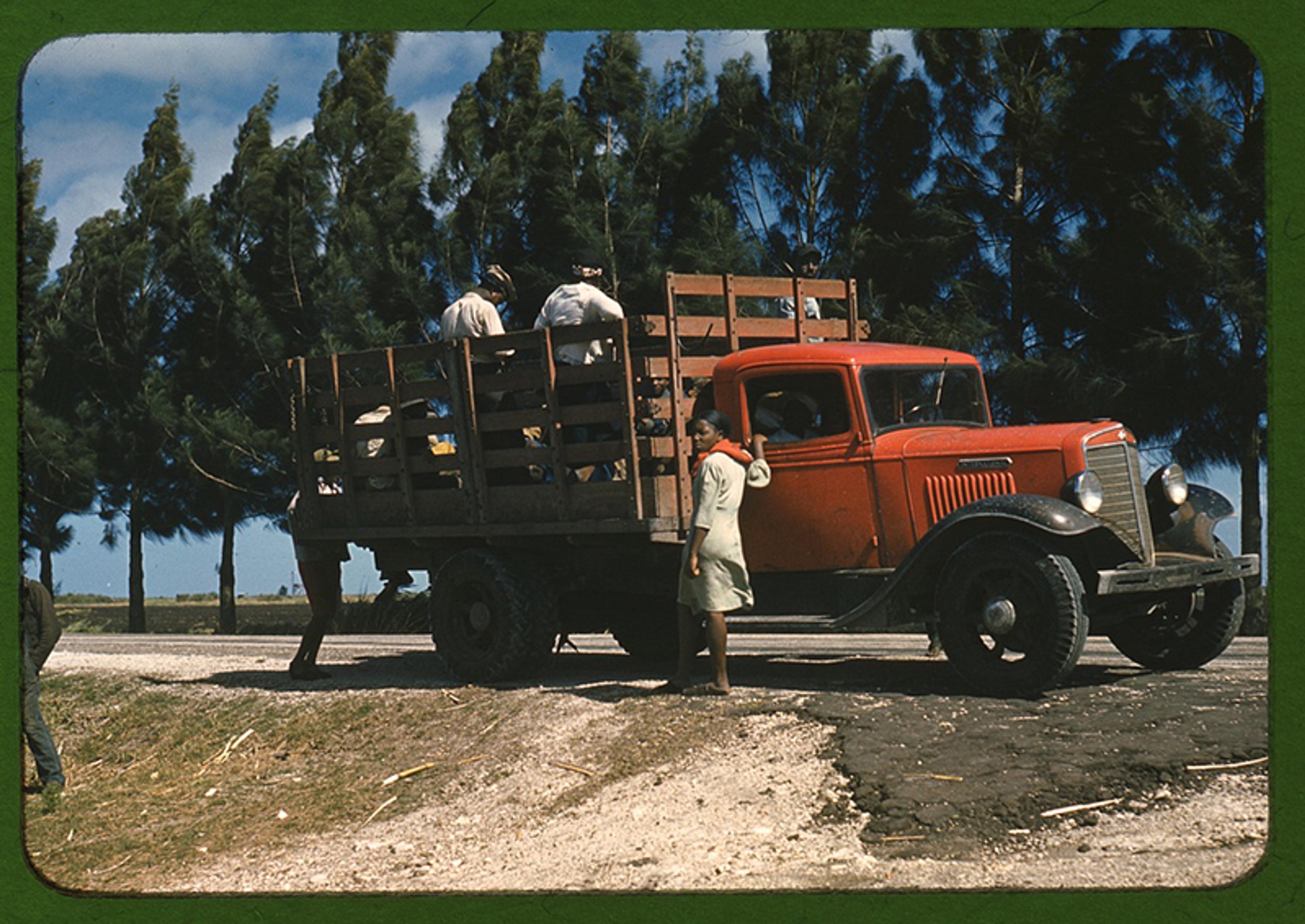
Field workers in Mississippi circa 1940
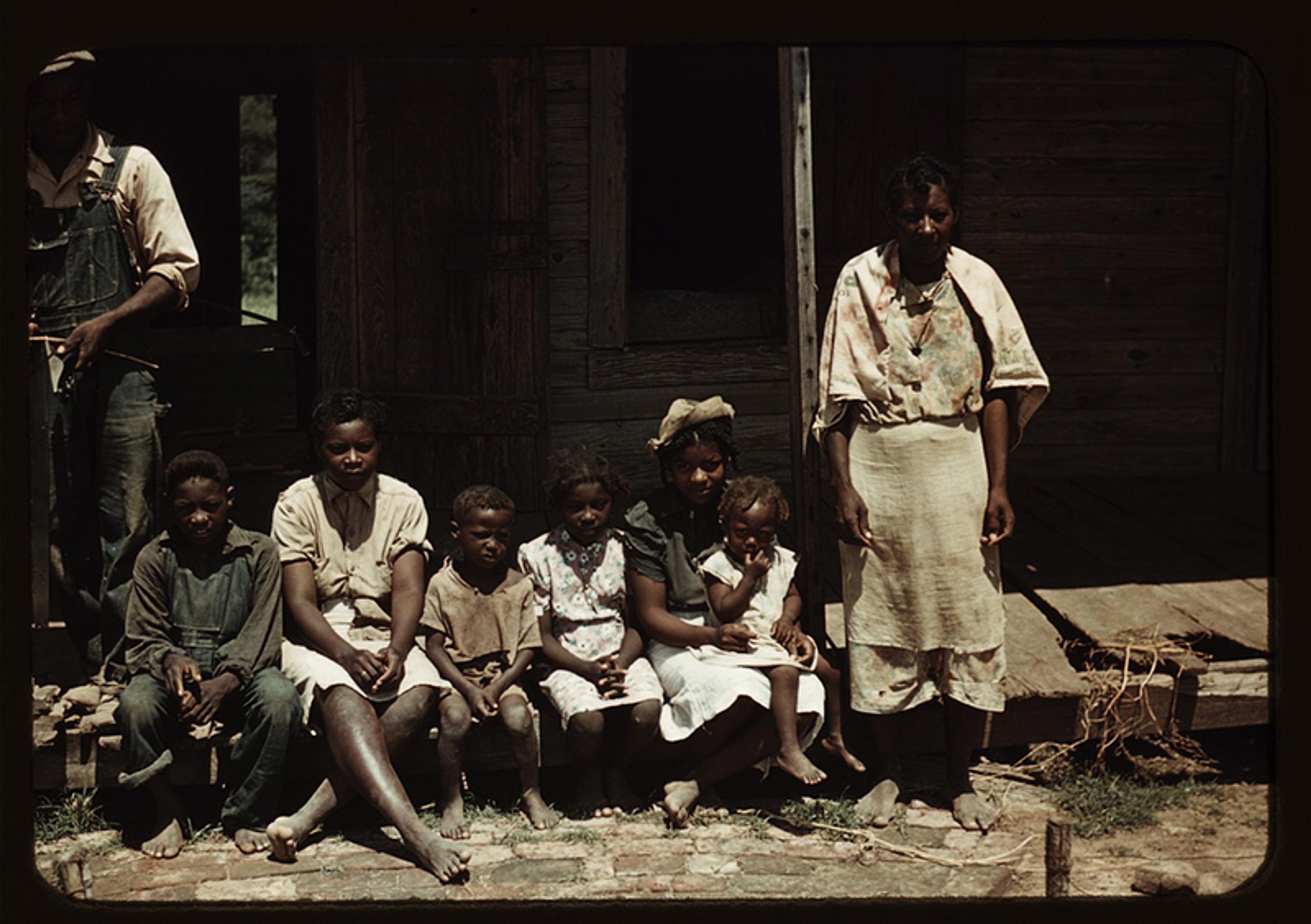
Bayou Bourbeau plantation, Natchitoches, Louisiana. August 1940
1 of 3
Following the Great Depression, which hit the rural, already-impoverished South harder than it did the rest of the nation, the New Deal influx of money, federal programmes, jobs and infrastructure helped bring the region fully into the 20th century. Perhaps most importantly, in the 1930s Roosevelt’s New Deal finally broke up the power stranglehold by the big land (plantation) owners. The South was finally able to evolve from an agricultural labour market that had pre-capitalist characteristics, shifting to a much larger industrial workforce during the Second World War. Some $4 billion in federal spending poured into the region, funding military facilities and forever ending the isolated labour market. Since 1940, the South has outperformed the rest of the US in income, job and construction growth, finally reaching about 90 per cent of national per-capita income norms. It has also remained critically behind in multiple important infrastructural and development measurements, from education and transit to poverty levels and healthcare.
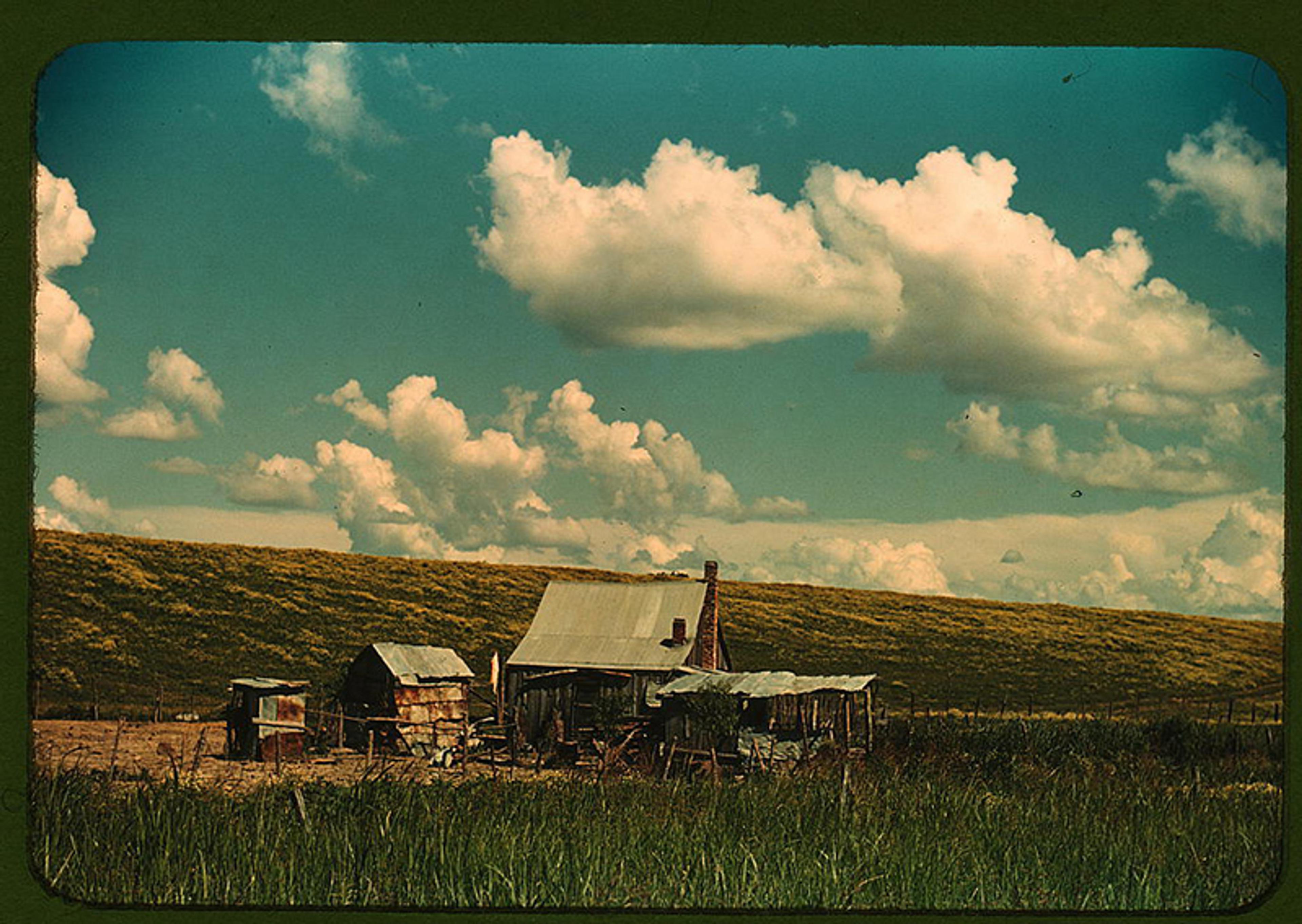
An African-American tenant’s house beside the Mississippi River levee, near Lake Providence, Louisiana. June 1940. Photo by Marion Post Wolcott/Library of Congress
Without question, the Second World War changed the South for the better. War industry jobs pulled workers from rural areas, forcing southern farms to finally mechanise. This mechanisation meant the destruction of sharecropping and tenant farming, as well as debt peonage. Workers in the South would finally be paid in wages – in cold, hard cash. And that fact was incredibly freeing.
Outside of extractive industries, the type of industry that came to dominate the South was reliant on intensive, low-wage labour, a striking difference with the rest of the US. ‘A low-wage region in a high-wage country,’ the South industrialised in a way that preserved and reinforced the class and racial status quo, even when corporations were owned by men from outside the region. Instead of being an agent of radical change, southern industrialisation preserved the region’s legacies of low taxes for the wealthy, heavy-handed labour control, and little in the way of governmental oversight or regulation.
Development is, quite simply, an essential part of restorative justice
Even as the South experienced a period of relative prosperity from the Second World War to the 1990s, with development at its peak, it never quite caught up to the rest of the nation. While there were myriad reasons for this remaining gap, historians have attempted to explain them with a type of regional dependency theory. Referring to the old Confederacy as a ‘colonial economy’, they argued that northern-owned corporations controlled southern money and power, extracting resources and exploiting cheap labour, siphoning both profits and tax dollars away from the impoverished region – all while maintaining racist practices. Adding insult to injury was that the southern economy became the domain of men from outside the South, men with no stake in the local communities their decisions ultimately affected (indeed, often devastated).
Whether or not the South was truly a colonial economy, framing it as such highlighted that the region remained impoverished, infrastructurally stunted, and underdeveloped. Even the golden era of the sunbelt South came to a bitter end by the close of the 20th century. Rural developmental problems began as far back as the 1980s, as local banks began shuttering and hospitals closed. Things worsened in the 1990s, as the economic growth the South enjoyed for decades came crashing to a halt when federal trade deals eviscerated manufacturing. The racial tolerance and progress made possible by labour unions and working-class solidarity began to erode; deindustrialisation profoundly changed the region. Never having invested much in public services, state governments continued to slash budgets through the 2000s. This not only stalled new development, it also let much of the states’ infrastructure, education and healthcare plans fall deeply into trouble, perhaps disrepair.
To address the continuing developmental gap in the poorest areas of the US, the country’s staggering levels of inequality must be addressed. Using policy to redistribute property, the South – and the nation – may finally be brought up to the standards of the rest of the developed world. From universal healthcare and a thriving public education sector to functional public transportation and reliable infrastructure, development is, quite simply, an essential part of restorative justice. With deeply progressive taxation coupled with democratic reforms, the right to organise and collectively bargain may be preserved; the right to retire fully funded; the historically racist criminal justice system switched to a Nordic model. Even the poorest rural Americans could lead lives with dignity due to governmental programmes such as a universal basic income (which would immediately lift more than 43 million people out of poverty) and a federal jobs guarantee – a concept derivative of the best aspects of the New Deal.
Today, more than a lifetime after Roosevelt’s declaration of the South as the ‘the nation’s No 1 economic problem’, nothing has changed. The South remains poor, underdeveloped, and lags behind the rest of the country by every measurable standard. It is a moral blight on the nation’s conscience, and far past time to truly lift the region out of poverty, and into the 21st century.
No comments:
Post a Comment